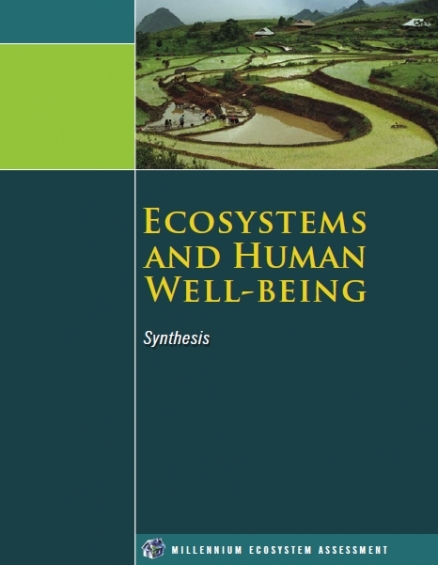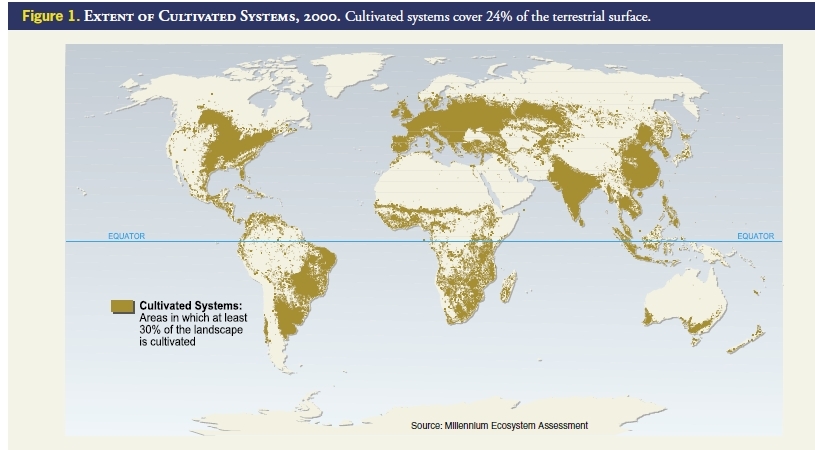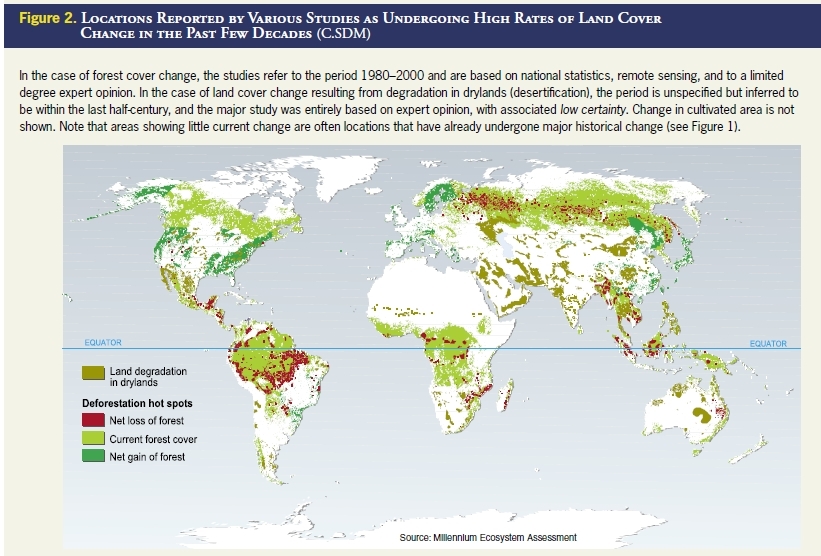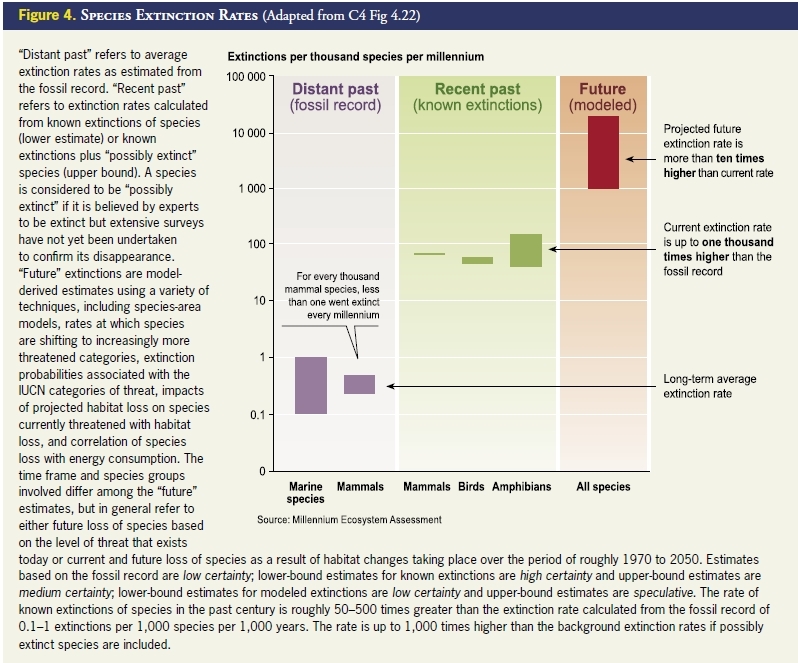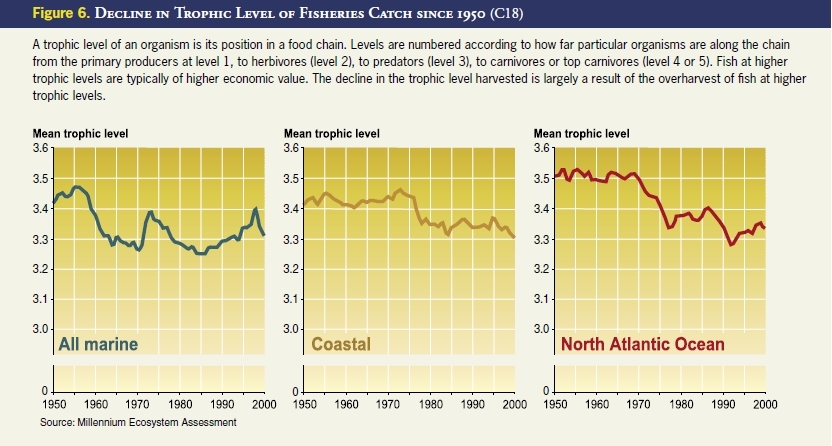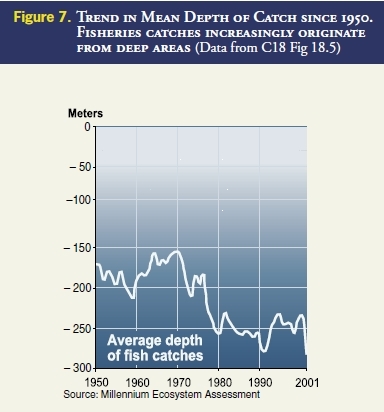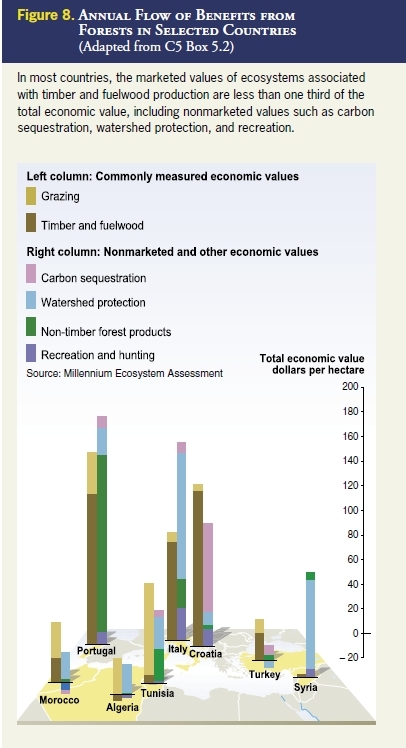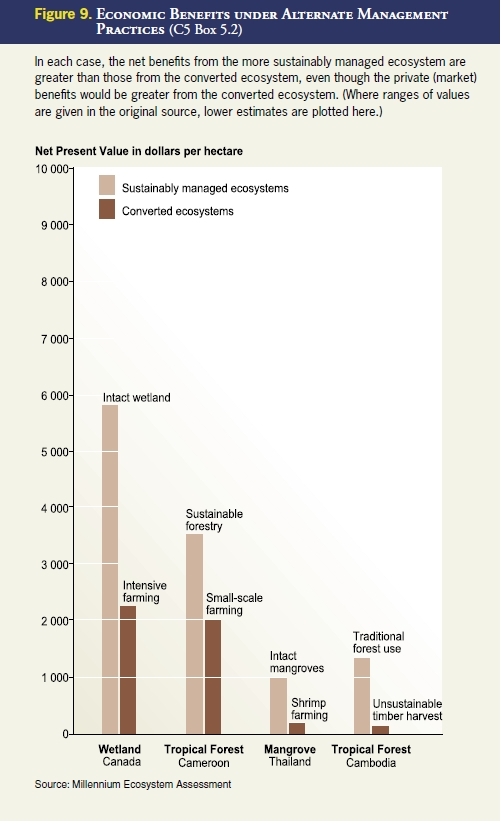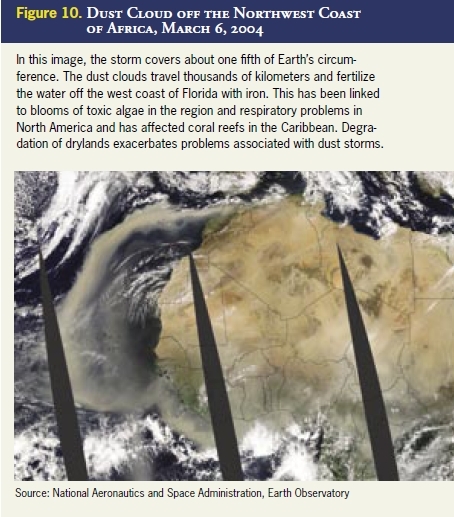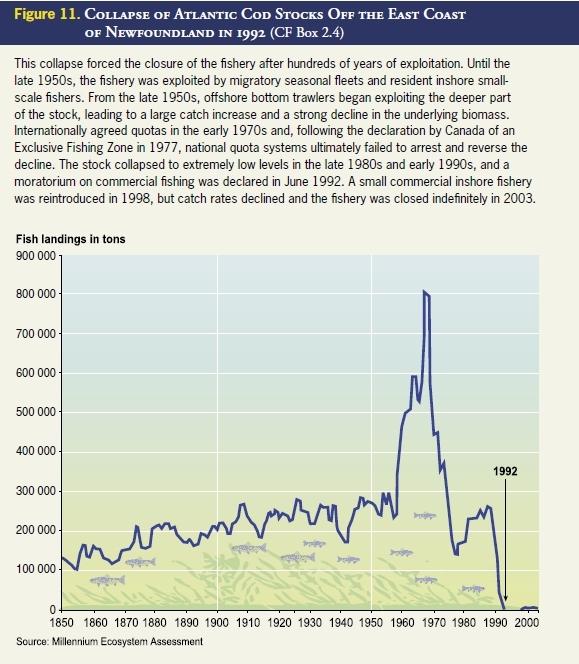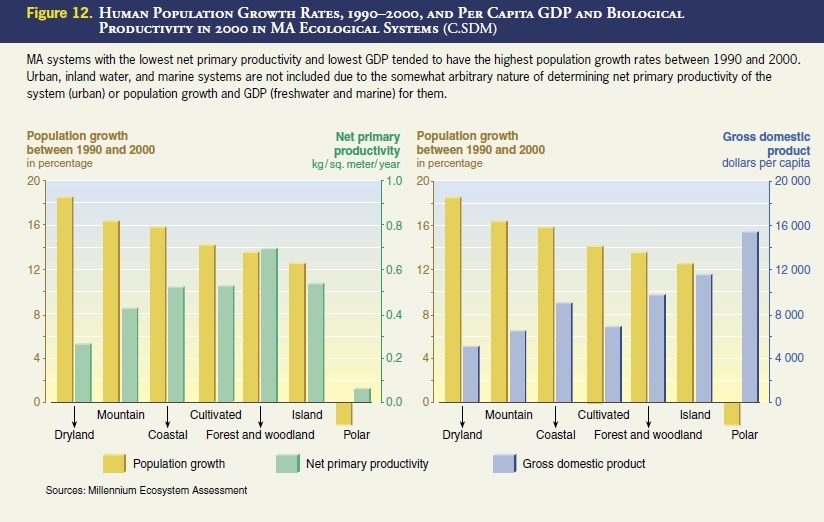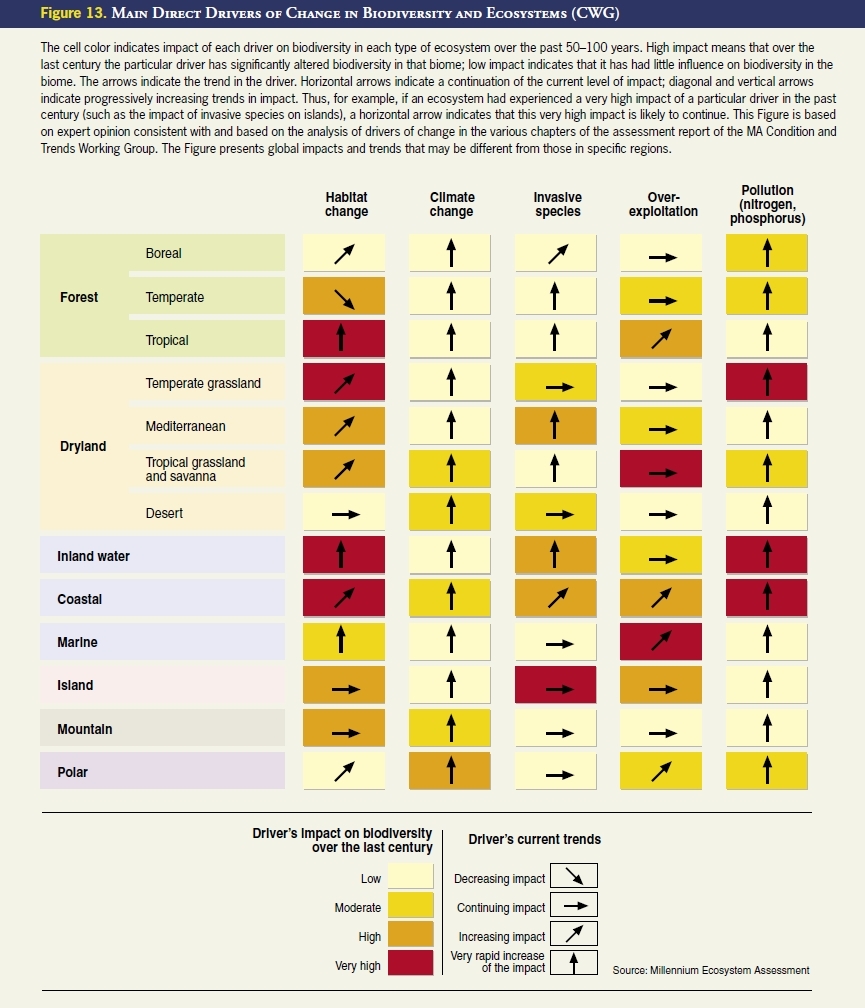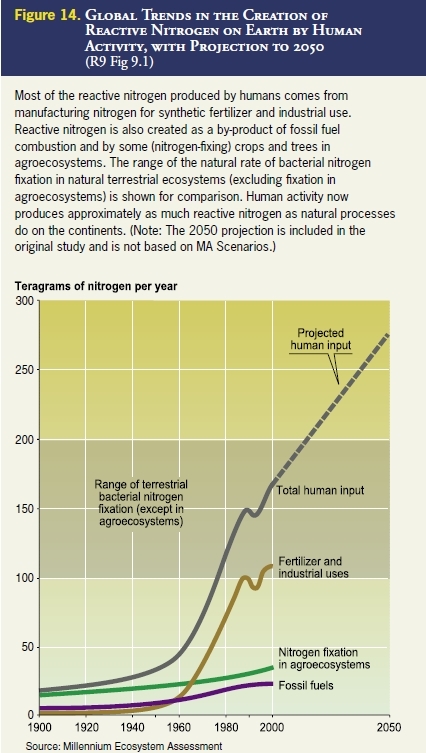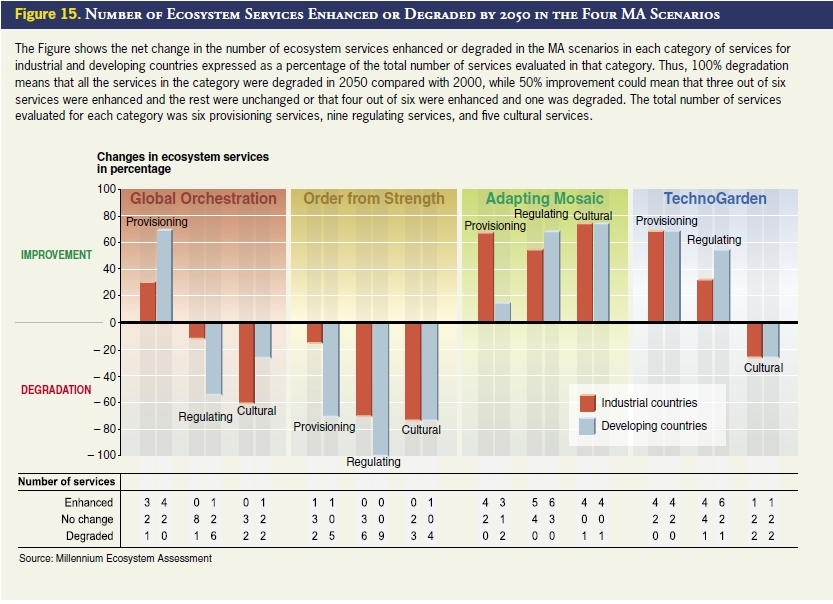Ecosystems and Human Well-being Synthesis: Summary for Decision-makers
This is part of the Millenium Ecosystem Assessment report Ecosystems and Human Well-Being Synthesis
Everyone in the world depends completely on Earth’s ecosystems and the services they provide, such as food, water, disease management, climate regulation, spiritual fulfillment, and aesthetic enjoyment. Over the past 50 years, humans have changed these ecosystems more rapidly and extensively than in any comparable period of time in human history, largely to meet rapidly growing demands for food, fresh water, timber, fiber, and fuel. This transformation of the planet has contributed to substantial net gains in human well-being and economic development (Patterns of economic growth and development). But not all regions and groups of people have benefited from this process—in fact, many have been harmed. Moreover, the full costs associated with these gains are only now becoming apparent.
|
Four Main Findings |
|
Three major problems associated with our management of the world’s ecosystems are already causing significant harm to some people, particularly the poor, and unless addressed will substantially diminish the long-term benefits we obtain from ecosystems:
- First, approximately 60% (15 out of 24) of the ecosystem services examined during the Millennium Ecosystem Assessment are being degraded or used unsustainably, including fresh water, capture fisheries (Fisheries and aquaculture), air and water purification, and the regulation of regional and local climate, natural hazards, and pests. The full costs of the loss and degradation of these ecosystem services are difficult to measure, but the available evidence demonstrates that they are substantial and growing. Many ecosystem services have been degraded as a consequence of actions taken to increase the supply of other services, such as food. These trade-offs often shift the costs of degradation from one group of people to another or defer costs to future generations.
- Second, there is established but incomplete evidence that changes being made in ecosystems are increasing the likelihood of nonlinear changes in ecosystems (including accelerating, abrupt, and potentially irreversible changes) that have important consequences for human well-being. Examples of such changes include disease emergence, abrupt alterations in water quality, the creation of “dead zones” in coastal waters, the collapse of fisheries, and shifts in regional climate.
- Third, the harmful effects of the degradation of ecosystem services (the persistent decrease in the capacity of an ecosystem to deliver services) are being borne disproportionately by the poor, are contributing to growing inequities and disparities across groups of people, and are sometimes the principal factor causing poverty and social conflict. This is not to say that ecosystem changes such as increased food production have not also helped to lift many people out of poverty or hunger, but these changes have harmed other individuals and communities, and their plight has been largely overlooked. In all regions, and particularly in sub-Saharan Africa, the condition and management of ecosystem services is a dominant factor influencing prospects for reducing poverty.
The degradation of ecosystem services is already a significant barrier to achieving the Millennium Development Goals agreed to by the international community in September 2000 and the harmful consequences of this degradation could grow significantly worse in the next 50 years. The consumption of ecosystem services, which is unsustainable in many cases, will continue to grow as a consequence of a likely three- to sixfold increase in global GDP by 2050 even while global population (Population growth rate) growth is expected to slow and level off in mid-century. Most of the important direct drivers of ecosystem change are unlikely to diminish in the first half of the century and two drivers— climate change and excessive nutrient loading—will become more severe.
Already, many of the regions facing the greatest challenges in achieving the MDGs coincide with those facing significant problems of ecosystem degradation. Rural poor people, a primary target of the MDGs, tend to be most directly reliant on ecosystem services and most vulnerable to changes in those services. More generally, any progress achieved in addressing the MDGs of poverty and hunger eradication, improved health, and environmental sustainability is unlikely to be sustained if most of the ecosystem services on which humanity relies continue to be degraded. In contrast, the sound management of ecosystem services provides cost-effective opportunities for addressing multiple development goals in a synergistic manner.
There is no simple fix to these problems since they arise from the interaction of many recognized challenges, including climate change, biodiversity loss, and land degradation, each of which is complex to address in its own right. Past actions to slow or reverse the degradation of ecosystems have yielded significant benefits, but these improvements have generally not kept pace with growing pressures and demands. Nevertheless, there is tremendous scope for action to reduce the severity of these problems in the coming decades. Indeed, three of four detailed scenarios examined by the MA suggest that significant changes in policies, institutions, and practices can mitigate some but not all of the negative consequences of growing pressures on ecosystems. But the changes required are substantial and are not currently under way.
An effective set of responses to ensure the sustainable management of ecosystems requires substantial changes in institutions and governance, economic policies and incentives, social and behavior factors, technology, and knowledge. Actions such as the integration of ecosystem management goals in various sectors (such as agriculture, forestry, finance, trade, and health), increased transparency and accountability of government and private-sector performance in ecosystem management, elimination of perverse subsidies, greater use of economic instruments and market-based approaches, empowerment of groups dependent on ecosystem services or affected by their degradation, promotion of technologies enabling increased crop yields without harmful environmental impacts, ecosystem restoration, and the incorporation of non-market values of ecosystems and their services in management decisions all could substantially lessen the severity of these problems in the next several decades.
The remainder of this Summary for Decision-makers presents the four major findings of the Millennium Ecosystem Assessment on the problems to be addressed and the actions needed to enhance the conservation and sustainable use of ecosystems.
Contents
Finding 1: Ecosystem Change in Last 50 Years
|
|
|
Over the past 50 years, humans have changed ecosystems more rapidly and extensively than in any comparable period of time in human history, largely to meet rapidly growing demands for food, fresh water, timber, fiber, and fuel. This has resulted in a substantial and largely irreversible loss in the diversity of life on Earth. |
The structure and functioning of the world’s ecosystems changed more rapidly in the second half of the twentieth century than at any time in human history. [1]
- More land was converted to cropland in the 30 years after 1950 than in the 150 years between 1700 and 1850. Cultivated systems (areas where at least 30% of the landscape is in croplands, shifting cultivation, confined livestock production, or freshwater aquaculture) now cover one quarter of Earth’s terrestrial surface. (See Figure 1.) Areas of rapid change in forest land cover and land degradation are shown in Figure 2.
- Approximately 20% of the world’s coral reefs were lost and an additional 20% degraded in the last several decades of the twentieth century, and approximately 35% of mangrove area was lost during this time (in countries for which sufficient data exist, which encompass about half of the area of mangroves).
- The amount of water impounded behind dams quadrupled since 1960, and three to six times as much water is held in reservoirs as in natural rivers. Water withdrawals from rivers and lakes doubled since 1960; most water use (70% worldwide) is for agriculture.
- Since 1960, flows of reactive (biologically available) nitrogen in terrestrial ecosystems have doubled, and flows of phosphorus have tripled. More than half of all the synthetic nitrogen fertilizer, which was first manufactured in 1913, ever used on the planet has been used since 1985.
- Since 1750, the atmospheric concentration of carbon dioxide has increased by about 32% (from about 280 to 376 parts per million in 2003), primarily due to the combustion of fossil fuels and land use changes. Approximat
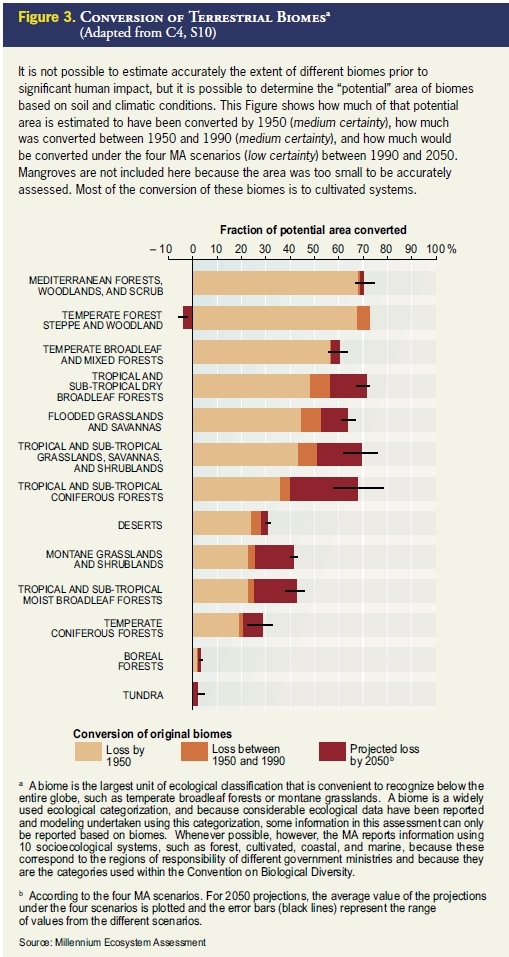 ely 60% of that increase (60 parts per million) has taken place since 1959.
ely 60% of that increase (60 parts per million) has taken place since 1959.
Humans are fundamentally, and to a significant extent irreversibly, changing the diversity of life on Earth, and most of these changes represent a loss of biodiversity. [1]
- More than two thirds of the area of 2 of the world’s 14 major [[terrestrial] biomes] and more than half of the area of 4 other biomes had been converted by 1990, primarily to agriculture. (See Figure 3.)
- Across a range of taxonomic groups, either the population (Population growth rate) size or range or both of the majority of species is currently declining.
- The distribution of species on Earth is becoming more homogenous; in other words, the set of species in any one region of the world is becoming more similar to the set in other regions primarily as a result of introductions of species, both intentionally and inadvertently in association with increased travel and shipping.
- The number of species on the planet is declining. Over the past few hundred years, humans have increased the species extinction rate by as much as 1,000 times over background rates typical over the planet’s history (medium certainty). (See Figure 4.) Some 10–30% of mammal, bird, and amphibian species are currently threatened with extinction (medium to high certainty). Freshwater (Freshwater biomes) ecosystems tend to have the highest proportion of species threatened with extinction.
- Genetic diversity has declined globally, particularly among cultivated species.
Most changes to ecosystems have been made to meet a dramatic growth in the demand for food, water, timber, fiber, and fuel. [2] Some ecosystem changes have been the inadvertent result of activities unrelated to the use of ecosystem services, such as the construction of roads, ports, and cities and the discharge of pollutants. But most ecosystem changes were the direct or indirect result of changes made to meet growing demands for ecosystem services, and in particular growing demands for food, water, timber, fiber, and fuel (fuelwood and hydropower). Between 1960 and 2000, the demand for ecosystem services grew significantly as world population (Population growth rate) doubled to 6 billion people and the global economy increased more than sixfold. To meet this demand, food production increased by roughly two-and-a half times, water use doubled, wood harvests for pulp and paper production tripled, installed hydropower capacity doubled, and timber production increased by more than half.
The growing demand for these ecosystem services was met both by consuming an increasing fraction of the available supply (for example, diverting more water for irrigation or capturing more fish from the sea) and by raising the production of some services, such as crops and livestock. The latter has been accomplished through the use of new technologies (such as new crop varieties, fertilization, and irrigation) as well as through increasing the area managed for the services in the case of crop and livestock production and aquaculture.
Finding 2: Gains and Losses from Ecosystem Change
|
|
|
The changes that have been made to ecosystems have contributed to substantial net gains in human well-being and economic development (Patterns of economic growth and development), but these gains have been achieved at growing costs in the form of the degradation of many ecosystem services, increased risks of nonlinear changes, and the exacerbation of poverty for some groups of people. These problems, unless addressed, will substantially diminish the benefits that future generations obtain from ecosystems. |
In the aggregate, and for most countries, changes made to the world’s ecosystems in recent decades have provided substantial benefits for human well-being and national development. [3] Many of the most significant changes to ecosystems have been essential to meet growing needs for food and water; these changes have helped reduce the proportion of malnourished people and improved human health. Agriculture, including fisheries (Fisheries and aquaculture) and forestry, has been the mainstay of strategies for the development of countries for centuries, providing revenues that have enabled investments in industrialization and poverty alleviation. Although the value of food production in 2000 was only about 3% of gross world product, the agricultural labor force accounts for approximately 22% of the world’s population, half the world’s total labor force, and 24% of GDP in countries with per capita incomes of less than $765 (the low-income developing countries, as defined by the World Bank).
These gains have been achieved, however, at growing costs in the form of the degradation of many ecosystem services, increased risks of nonlinear changes in ecosystems, the exacerbation of poverty for some people, and growing inequities and disparities across groups of people.
Degradation and Unsustainable Use of Ecosystem Services
Approximately 60% (15 out of 24) of the ecosystem services evaluated in this assessment (including 70% of regulating and cultural services) are being degraded or used unsustainably. [2] (See Table 1.) Ecosystem services that have been degraded over the past 50 years include capture fisheries (Fisheries and aquaculture), water supply, waste treatment and detoxification, water purification, natural hazard protection, regulation of air quality, regulation of regional and local climate, regulation of erosion, spiritual fulfillment, and aesthetic enjoyment. The use of two ecosystem services—capture fisheries and fresh water—is now well beyond levels that can be sustained even at current demands, much less future ones. At least one quarter of important commercial fish stocks are over-harvested (high certainty). (See Figures 5, 6, and 7.) From 5% to possibly 25% of global freshwater use exceeds long-term accessible supplies and is now met either through engineered water transfers or overdraft of groundwater supplies (low to medium certainty). Some 15–35% of irrigation withdrawals exceed supply rates and are therefore unsustainable (low to medium certainty). While 15 services have been degraded, only 4 have been enhanced in the past 50 years, three of which involve food production: crops, livestock, and aquaculture. Terrestrial ecosystems were on average a net source of CO2 emissions during the nineteenth and early twentieth centuries, but became a net sink around the middle of the last century, and thus in the last 50 years the role of ecosystems in regulating global climate through carbon sequestration has also been enhanced.
Actions to increase one ecosystem service often cause the degradation of other services. 6 For example, because actions to increase food production typically involve increased use of water and [[fertilizer]s] or expansion of the area of cultivated land, these same actions often degrade other ecosystem services, including reducing the availability of water for other uses, degrading water quality, reducing biodiversity, and decreasing forest cover (which in turn may lead to the loss of forest products and the release of greenhouse gasses). Similarly, the conversion of forest to agriculture can significantly change the frequency and magnitude of floods, although the nature of this impact depends on the characteristics of the local ecosystem and the type of land cover change.
The degradation of ecosystem services often causes significant harm to human well-being. 6 The information available to assess the consequences of changes in ecosystem services for human well-being is relatively limited. Many ecosystem services have not been monitored, and it is also difficult to estimate the influence of changes in ecosystem services relative to other social, cultural, and economic factors that also affect human well-being. Nevertheless, the following types of evidence demonstrate that the harmful effects of the degradation of ecosystem services on livelihoods, health, and local and national economies are substantial.
- Most resource management decisions are most strongly influenced by ecosystem services entering [[market]s]; as a result, the nonmarketed benefits are often lost or degraded. These nonmarketed benefits are often high and sometimes more valuable than the marketed ones. For example, one of the most comprehensive studies to date, which examined the marketed and nonmarketed economic values associated with forests in eight Mediterranean countries, found that timber and fuelwood generally accounted for less than a third of total economic value (Monetary valuation) of forests in each country. (See Figure 8.) Values associated with non-wood forest products, recreation, hunting, watershed protection, carbon sequestration, and passive use (values independent of direct uses) accounted for between 25% and 96% of the total economic value of the forests.
- The total economic value associated with managing ecosystems more sustainably is often higher than the value associated with the conversion of the ecosystem through farming, clear-cut logging, or other intensive uses. Relatively few studies have compared the total economic value (including values of both marketed and nonmarketed ecosystem services) of ecosystems under alternate management regimes, but some of the studies that do exist have found that the benefit of managing the ecosystem more sustainably exceeded that of converting the ecosystem. (See Figure 9.)
- The economic and public health costs associated with damage to ecosystem services can be substantial.
- The early 1990s collapse of the Newfoundland cod fishery due to overfishing resulted in the loss of tens of thousands of jobs and cost at least $2 billion in income support and retraining.
- In 1996, the cost of U.K. agriculture resulting from the damage that agricultural practices cause to water (pollution (Water pollution) and eutrophication, a process whereby excessive plant growth depletes oxygen in the water), air (emissions of greenhouse gases), soil (off-site erosion damage, emissions of greenhouse gases), and biodiversity was $2.6 billion, or 9% of average yearly gross farm receipts for the 1990s. Similarly, the damage costs of freshwater eutrophication alone in England and Wales (involving factors including reduced value of waterfront dwellings, water treatment costs, reduced recreational value of water bodies, and tourism losses) was estimated to be $105–160 million per year in the 1990s, with an additional $77 million a year being spent to address those damages.
- The incidence of diseases of marine organisms and the emergence of new pathogens is increasing, and some of these, such as ciguatera, harm human health. Episodes of harmful (including toxic) algal blooms in coastal waters are increasing in frequency and intensity, harming other marine resources such as fisheries as well as human health. In a particularly severe outbreak in Italy in 1989, harmful algal blooms cost the coastal aquaculture industry $10 million and the Italian tourism industry $11.4 million.
- The frequency and impact of floods and fires has increased significantly in the past 50 years, in part due to ecosystem changes. Examples are the increased susceptibility of coastal populations to tropical storms when mangrove forests are cleared and the increase in downstream flooding that followed land use changes in the upper Yangtze River. Annual economic losses from extreme events increased tenfold from the 1950s to approximately $70 billion in 2003, of which natural catastrophes (floods, fires, storms, drought, earthquakes) accounted for 84% of insured losses.
- The impact of the loss of cultural services is particularly difficult to measure, but it is especially important for many people. Human cultures, knowledge systems, religions, and social interactions have been strongly influenced by ecosystems. A number of the MA sub-global assessments found that spiritual and cultural values of ecosystems were as important as other services for many local communities, both in developing countries (the importance of sacred groves of forest in India, for example) and industrial ones (the importance of urban parks, for instance).
The degradation of ecosystem services represents loss of a capital asset. [3] Both renewable resources such as ecosystem services and nonrenewable resources such as mineral deposits, some soil nutrients, and fossil fuels are capital assets. Yet traditional national accounts do not include measures of resource depletion or of the degradation of these resources. As a result, a country could cut its [[forest]s] and deplete its fisheries (Fisheries and aquaculture), and this would show only as a positive gain in GDP (a measure of current economic well-being) without registering the corresponding decline in assets (wealth) that is the more appropriate measure of future economic well-being. Moreover, many ecosystem services (such as fresh water in aquifers and the use of the atmosphere as a sink for pollutants (Air pollution emissions)) are available freely to those who use them, and so again their degradation is not reflected in standard economic measures.
When estimates of the economic losses associated with the depletion of natural assets are factored into measurements of the total wealth of nations, they significantly change the balance sheet of countries with economies significantly dependent on natural resources. For example, countries such as Ecuador, Ethiopia, Kazakhstan, Democratic Republic of Congo, Trinidad and Tobago, Uzbekistan, and Venezuela that had positive growth in net savings in 2001, reflecting a growth in the net wealth of the country, actually experienced a loss in net savings when depletion of natural resources (energy and forests) and estimated damages from carbon emissions (associated with contributions to climate change) were factored into the accounts.
While degradation of some services may sometimes be warranted to produce a greater gain in other services, often more degradation of ecosystem services takes place than is in society’s interests because many of the services degraded are “public goods.” [3] Although people benefit from ecosystem services such as the regulation of air and water quality or the presence of an aesthetically pleasing landscape, there is no market for these services and no one person has an incentive to pay to maintain the good. And when an action results in the degradation of a service that harms other individuals, no market mechanism exists (nor, in many cases, could it exist) to ensure that the individuals harmed are compensated for the damages they suffer.
Wealthy populations cannot be insulated from the degradation of ecosystem services. [3] Agriculture, fisheries, and forestry once formed the bulk of national economies, and the control of natural resources dominated policy agendas. But while these natural resource industries are often still important, the relative economic and political significance of other industries in industrial countries has grown over the past century as a result of the ongoing transition from agricultural to industrial and service economies, urbanization, and the development of new technologies to increase the production of some services and provide substitutes for others. Nevertheless, the degradation of ecosystem services influences human well-being in industrial regions and among wealthy [[population]s] in developing countries in many ways:
- The physical, economic, or social impacts of ecosystem service degradation may cross boundaries. (See Figure 10.) For example, land degradation and associated dust storms or fires in one country can degrade air quality in other countries nearby.
- Degradation of ecosystem services exacerbates poverty in developing countries, which can affect neighboring industrial countries by slowing regional economic growth and contributing to the outbreak of conflicts or the migration of refugees.
- Changes in ecosystems that contribute to greenhouse gas emissions contribute to global [[climate change]s] that affect all countries.
- Many industries still depend directly on ecosystem services. The collapse of fisheries, for example, has harmed many communities in industrial countries. Prospects for the forest, agriculture, fishing, and ecotourism industries are all directly tied to ecosystem services, while other sectors such as insurance, banking, and health are strongly, if less directly, influenced by changes in ecosystem services.
- Wealthy populations of people are insulated from the harmful effects of some aspects of ecosystem degradation, but not all. For example, substitutes are typically not available when cultural services are lost.
- Even though the relative economic importance of agriculture, fisheries, and forestry is declining in industrial countries, the importance of other ecosystem services such as aesthetic enjoyment and recreational options is growing.
It is difficult to assess the implications of ecosystem changes and to manage ecosystems effectively because many of the effects are slow to become apparent, because they may be expressed primarily at some distance from where the ecosystem was changed, and because the costs and benefits of changes often accrue to different sets of stakeholders. [7] Substantial inertia (delay in the response of a system to a disturbance) exists in ecological systems. As a result, long time lags often occur between a change in a driver and the time when the full consequences of that change become apparent. For example, phosphorus is accumulating in large quantities in many agricultural [[soil]s], threatening rivers, lakes, and coastal oceans with increased eutrophication. But it may take years or decades for the full impact of the phosphorus to become apparent through erosion and other processes. Similarly, it will take centuries for global temperatures to reach equilibrium with changed concentrations of greenhouse gases in the atmosphere and even more time for biological systems to respond to the changes in climate.
Moreover, some of the impacts of ecosystem changes may be experienced only at some distance from where the change occurred. For example, changes in upstream catchments affect water flow and water quality in downstream regions; similarly, the loss of an important fish nursery area in a coastal wetland may diminish fish catch some distance away. Both the inertia in ecological systems and the temporal and spatial separation of costs and benefits of ecosystem changes often result in situations where the individuals experiencing harm from ecosystem changes (future generations, say, or downstream landowners) are not the same as the individuals gaining the benefits. These temporal and spatial patterns make it extremely difficult to fully assess costs and benefits associated with ecosystem changes or to attribute costs and benefits to different stakeholders. Moreover, the institutional arrangements now in place to manage ecosystems are poorly designed to cope with these challenges.
Increased Likelihood of Nonlinear (Stepped) and Potentially Abrupt Changes in Ecosystems
There is established but incomplete evidence that changes being made in ecosystems are increasing the likelihood of nonlinear changes in ecosystems (including accelerating, abrupt, and potentially irreversible changes), with important consequences for human well-being. [7] Changes in ecosystems generally take place gradually. Some changes are nonlinear, however: once a threshold is crossed, the system changes to a very different state. And these nonlinear changes are sometimes abrupt; they can also be large in magnitude and difficult, expensive, or impossible to reverse. Capabilities for predicting some nonlinear changes are improving, but for most ecosystems and for most potential nonlinear changes, while science can often warn of increased risks of change it cannot predict the thresholds at which the change will be encountered. Examples of large-magnitude nonlinear changes include:
- Disease emergence. If, on average, each infected person infects at least one other person, then an epidemic spreads, while if the infection is transferred on average to less than one person, the epidemic dies out. During the 1997–98 El Niño, excessive flooding caused cholera epidemics in Djibouti, Somalia, Kenya, Tanzania, and Mozambique. Warming of the African Great Lakes due to climate change may create conditions that increase the risk of cholera transmission in the surrounding countries.
- Eutrophication and hypoxia. Once a threshold of nutrient loading is achieved, changes in freshwater and coastal ecosystems can be abrupt and extensive, creating harmful algal blooms (including blooms of toxic species) and sometimes leading to the formation of oxygen-depleted zones, killing most animal life.
- Fisheries collapse. For example, the Atlantic cod stocks off the east coast of Newfoundland collapsed in 1992, forcing the closure of the fishery after hundreds of years of exploitation. (See Figure 11.) Most important, depleted stocks may take years to recover, or not recover at all, even if harvesting is significantly reduced or eliminated entirely.
- Species introductions and losses. The introduction of the zebra mussel into aquatic systems in the United States, for instance, resulted in the extirpation of native clams in Lake St. Clair and annual costs of $100 million to the power industry and other users.
- Regional climate change. Deforestation generally leads to decreased rainfall. Since forest existence crucially depends on rainfall, the relationship between forest loss and precipitation decrease can form a positive feedback, which, under certain conditions, can lead to a nonlinear change in forest cover.
The growing bushmeat trade poses particularly significant threats associated with nonlinear changes, in this case accelerating rates of change. [7] Growth in the use and trade of bushmeat is placing increasing pressure on many species, especially in Africa and Asia. While the population size of harvested species may decline gradually with increasing harvest for some time, once the harvest exceeds sustainable levels, the rate of decline of [[population]s] of the harvested species will tend to accelerate. This could place them at risk of extinction and also reduce the food supply of people dependent on these resources in the longer term. At the same time, the bushmeat trade involves relatively high levels of interaction between humans and some relatively closely related wild animals that are eaten. Again, this increases the risk of a nonlinear change, in this case the emergence of new and serious pathogens. Given the speed and magnitude of international travel today, new pathogens could spread rapidly around the world.
The increased likelihood of these nonlinear changes stems from the loss of biodiversity and growing pressures from multiple direct drivers of ecosystem change. [7] The loss of species (Species diversity) and genetic diversity decreases the resilience of ecosystems, which is the level of disturbance that an ecosystem can undergo without crossing a threshold to a different structure or functioning. In addition, growing pressures from drivers such as over-harvesting, climate change, invasive species, and nutrient loading push ecosystems toward thresholds that they might otherwise not encounter.
Exacerbation of Poverty for Some Individuals and Groups of People and Contribution to Growing Inequities and Disparities across Groups of People
Despite the progress achieved in increasing the production and use of some ecosystem services, levels of poverty remain high, inequities are growing, and many people still do not have a sufficient supply of or access to ecosystem services. [3]
- In 2001, 1.1 billion people survived on less than $1 per day of income, with roughly 70% of them in rural areas where they are highly dependent on agriculture, grazing, and hunting for subsistence.
- Inequality in income and other measures of human well-being has increased over the past decade. A child born in sub-Saharan Africa is 20 times more likely to die before age 5 than a child born in an industrial country, and this disparity is higher than it was a decade ago. During the 1990s, 21 countries experienced declines in their rankings in the Human Development Index (an aggregate measure of economic well-being, health, and education); 14 of them were in sub-Saharan Africa.
- Despite the growth in per capita food production in the past four decades, an estimated 852 million people were undernourished in 2000–02, up 37 million from the period 1997–99. South Asia and sub-Saharan Africa, the regions with the largest numbers of undernourished people, are also the regions where growth in per capita food production has lagged the most. Most notably, per capita food production has declined in sub-Saharan Africa.
- Some 1.1 billion people still lack access to improved water supply, and more than 2.6 billion lack access to improved sanitation. Water scarcity affects roughly 1–2 billion people worldwide. Since 1960, the ratio of water use to accessible supply has grown by 20% per decade.
The degradation of ecosystem services is harming many of the world’s poorest people and is sometimes the principal factor causing poverty. 6
- Half the urban population in Africa, Asia, Latin America, and the Caribbean suffers from one or more diseases associated with inadequate water and sanitation. Worldwide, approximately 1.7 million people die annually as a result of inadequate water, sanitation, and hygiene.
- The declining state of capture fisheries (Fisheries and aquaculture) is reducing an inexpensive source of protein in developing countries. Per capita fish consumption in developing countries, excluding China, declined between 1985 and 1997.
- Desertification affects the livelihoods of millions of people, including a large portion of the poor in drylands.
The pattern of “winners” and “losers” associated with ecosystem changes—and in particular the impact of ecosystem changes on poor people, women, and indigenous peoples— has not been adequately taken into account in management decisions. 6 Changes in ecosystems typically yield benefits for some people and exact costs on others who may either lose access to resources or livelihoods or be affected by externalities associated with the change. For several reasons, groups such as the poor, women, and indigenous communities have tended to be harmed by these changes.
- Many changes in ecosystem management have involved the privatization of what were formerly common pool resources. Individuals who depended on those resources (such as indigenous peoples, forest-dependent communities, and other groups relatively marginalized from political and economic sources of power) have often lost rights to the resources.
- Some of the people and places affected by changes in ecosystems and ecosystem services are highly vulnerable and poorly equipped to cope with the major changes in ecosystems that may occur. Highly vulnerable groups include those whose needs for ecosystem services already exceed the supply, such as people lacking adequate clean water supplies, and people living in areas with declining per capita agricultural production.
- Significant differences between the roles and rights of men and women in many societies lead to increased vulnerability of women to changes in ecosystem services.
- The reliance of the rural poor on ecosystem services is rarely measured and thus typically overlooked in national statistics and poverty assessments, resulting in inappropriate strategies that do not take into account the role of the environment in poverty reduction. For example, a recent study that synthesized data from 17 countries found that 22% of household income for rural communities in forested regions comes from sources typically not included in national statistics, such as harvesting wild food, fuelwood, fodder, medicinal plants, and timber. These activities generated a much higher proportion of poorer families’ total income than of wealthy families’, and this income was of particular significance in periods of both predictable and unpredictable shortfalls in other livelihood sources.
Development prospects in dryland regions of developing countries are especially dependent on actions to avoid the degradation of ecosystems and slow or reverse degradation where it is occurring. 5 Dryland systems cover about 41% of Earth’s land surface and more than 2 billion people inhabit them, more than 90% of whom are in developing countries. Dryland ecosystems (encompassing both rural and urban regions of drylands) experienced the highest [[population (Population growth rate) growth] rate] in the 1990s of any of the systems examined in the MA. (See Figure 12.) Although drylands are home to about one third of the human population, they have only 8% of the world’s renewable water supply. Given the low and variable rainfall, high temperatures, low soil organic matter, high costs of delivering services such as electricity or piped water, and limited investment in infrastructure due to the low population density, people living in drylands face many challenges. They also tend to have the lowest levels of human well-being, including the lowest per capita GDP and the highest infant mortality rates.
The combination of high variability in environmental conditions and relatively high levels of poverty leads to situations where people can be highly vulnerable to changes in ecosystems, although the presence of these conditions has led to the development of very resilient land management strategies. Pressures on dryland ecosystems already exceed sustainable levels for some ecosystem services, such as soil formation and water supply, and are growing. Per capita water availability is currently only two thirds of the level required for minimum levels of human well-being. Approximately 10–20% of the world’s drylands are degraded (medium certainty) directly harming the people living in these areas and indirectly harming a larger population through biophysical impacts (dust storms, greenhouse gas emissions, and regional climate change) and through socioeconomic impacts (human migration and deepening poverty sometimes contributing to conflict and instability). Despite these tremendous challenges, people living in drylands and their land management systems have a proven resilience and the capability of preventing land degradation, although this can be either undermined or enhanced by public policies and development strategies.
Finding 3: Ecosystem Prospects for Next 50 Years
|
|
|
The degradation of ecosystem services could grow significantly worse during the first half of this century and is a barrier to achieving the Millennium Development Goals. |
The MA developed four scenarios to explore plausible futures for ecosystems and human well-being. (See Box 1.) The scenarios explored two global development paths, one in which the world becomes increasingly globalized and the other in which it becomes increasingly regionalized as well as two different approaches to ecosystem management, one in which actions are reactive and most problems are addressed only after they become obvious and the other in which ecosystem management is proactive and policies deliberately seek to maintain ecosystem services for the long term.
|
Box 1. MA Scenarios |
|
The MA developed four scenarios to explore plausible futures for ecosystems and human well-being based on different assumptions about driving forces of change and their possible interactions: Global Orchestration – This scenario depicts a globally connected society that focuses on global trade (Global economy) and economic liberalization and takes a reactive approach to ecosystem problems but that also takes strong steps to reduce poverty and inequality and to invest in public goods such as infrastructure and education. Economic growth in this scenario is the highest of the four scenarios, while it is assumed to have the lowest population in 2050. Order from Strength – This scenario represents a regionalized and fragmented world, concerned with security and protection, emphasizing primarily regional [[market]s], paying little attention to public goods, and taking a reactive approach to ecosystem problems. Economic growth rates are the lowest of the scenarios (particularly low in developing countries) and decrease with time, while population (Population growth rate) growth is the highest. Adapting Mosaic – In this scenario, regional watershed-scale ecosystems are the focus of political and economic activity. Local institutions are strengthened and local ecosystem management strategies are common; societies develop a strongly proactive approach to the management of ecosystems. Economic growth rates are somewhat low initially but increase with time, and population in 2050 is nearly as high as in Order from Strength. TechnoGarden – This scenario depicts a globally connected world relying strongly on environmentally sound technology, using highly managed, often engineered, ecosystems to deliver ecosystem services, and taking a proactive approach to the management of ecosystems in an effort to avoid problems. Economic growth is relatively high and accelerates, while population in 2050 is in the midrange of the scenarios. The scenarios are not predictions; instead they were developed to explore the unpredictable features of change in drivers and ecosystem services. No scenario represents business as usual, although all begin from current conditions and trends. Both quantitative models and qualitative analyses were used to develop the scenarios. For some drivers (such as land use change and carbon emissions) and ecosystem services (water withdrawals, food production), quantitative projections were calculated using established, peer-reviewed global models. Other drivers (such as rates of technological change and economic growth), ecosystem services (particularly supporting and cultural services, such as soil formation and recreational opportunities), and human well-being indicators (such as human health and social relations) were estimated qualitatively. In general, the quantitative models used for these scenarios addressed incremental changes but failed to address thresholds, risk of extreme events, or impacts of large, extremely costly, or irreversible changes in ecosystem services. These phenomena were addressed qualitatively by considering the risks and impacts of large but unpredictable ecosystem changes in each scenario. Three of the scenarios – Global Orchestration, Adapting Mosaic, and TechnoGarden incorporate significant changes in policies aimed at addressing sustainable development challenges. In Global Orchestration trade barriers are eliminated, distorting subsidies (Perverse subsidies) are removed, and a major emphasis is placed on eliminating poverty and hunger. In Adapting Mosaic, by 2010, most countries are spending close to 13% of their GDP on education (as compared to an average of 3.5% in 2000), and institutional arrangements to promote transfer of skills and knowledge among regional groups proliferate. In TechnoGarden policies are put in place to provide payment to individuals and companies that provide or maintain the provision of ecosystem services. For example, in this scenario, by 2015, roughly 50% of European agriculture, and 10% of North American agriculture is aimed at balancing the production of food with the production of other ecosystem services. Under this scenario, significant advances occur in the development of environmental technologies to increase production of services, create substitutes, and reduce harmful trade-offs. |
Most of the direct drivers of change in ecosystems currently remain constant or are growing in intensity in most ecosystems. (See Figure 13.) In all four MA scenarios, the pressures on ecosystems are projected to continue to grow during the first half of this century. 5 The most important direct drivers of change in ecosystems are habitat change (land use change and physical modification of rivers or water withdrawal from rivers), overexploitation, invasive alien species, pollution, and climate change. These direct drivers are often synergistic. For example, in some locations land use change can result in greater nutrient loading (if the land is converted to high-intensity agriculture), increased emissions of greenhouse gases (if forest is cleared), and increased numbers of invasive species (due to the disturbed habitat).
- Habitat transformation, particularly from conversion to agriculture: Under the MA scenarios, a further 10–20% of grassland and forestland is projected to be converted between 2000 and 2050 (primarily to agriculture), as Figure 2 illustrated. The projected land conversion is concentrated in low-income countries and dryland regions. Forest cover is projected to continue to increase within industrial countries.
- Overexploitation, especially overfishing: Over much of the world, the biomass of fish targeted in fisheries (including that of both the target species and those caught incidently) has been reduced by 90% relative to levels prior to the onset of industrial fishing, and the fish being harvested are increasingly coming from the less valuable lower trophic levels as populations of higher trophic level species are depleted, as shown in Figure 6. These pressures continue to grow in all the MA scenarios.
- Invasive alien species: The spread of invasive alien species and disease organisms continues to increase because of both deliberate trans-locations and accidental introductions related to growing trade and travel, with significant harmful consequences to native species and many ecosystem services.
- Pollution, particularly nutrient loading: Humans have already doubled the flow of reactive nitrogen on the continents, and some projections suggest that this may increase by roughly a further two thirds by 2050. (See Figure 14.) Three out of four MA scenarios project that the global flux of nitrogen to coastal ecosystems will increase by a further 10–20% by 2030 (medium certainty), with almost all of this increase occurring in developing countries. Excessive flows of nitrogen contribute to eutrophication of freshwater and coastal marine ecosystems and acidification of freshwater (Freshwater biomes) and terrestrial ecosystems (with implications for biodiversity in these ecosystems). To some degree, nitrogen also plays a role in creation of ground-level ozone (which leads to loss of agricultural and forest productivity), destruction of ozone in the stratosphere (which leads to depletion of the ozone layer and increased UV-B radiation on Earth, causing increased incidence of skin cancer), and climate change. The resulting health effects include the consequences of ozone pollution (Air pollution emissions) on asthma and respiratory function, increased allergies and asthma due to increased pollen production, the risk of blue-baby syndrome, increased risk of cancer and other chronic diseases from nitrates in drinking water, and increased risk of a variety of pulmonary and cardiac diseases from the production of fine particles in the atmosphere.
- Anthropogenic Climate Change: Observed recent changes in climate, especially warmer regional temperatures, have already had significant impacts on biodiversity and ecosystems, including causing changes in species distributions, population (Population growth rate) sizes, the timing of reproduction or migration events, and an increase in the frequency of pest and disease outbreaks. Many coral reefs have undergone major, although often partially reversible, bleaching episodes when local sea surface temperatures have increased during one month by 0.5–1o Celsius above the average of the hottest months. By the end of the century, climate change and its impacts may be the dominant direct driver of biodiversity loss and changes in ecosystem services globally. The scenarios developed by the Intergovernmental Panel on Climate Change (Intergovernmental Panel on Climate Change (IPCC)) project an increase in global mean surface temperature of 2.0–6.4o Celsius above preindustrial levels by 2100, increased incidence of floods and droughts, and a rise in sea level of an additional 8–88 centimeters between 1990 and 2100. Harm to biodiversity will grow worldwide with increasing rates of change in climate and increasing absolute amounts of change. In contrast, some ecosystem services in some regions may initially be enhanced by projected changes in climate (such as increases in temperature or precipitation), and thus these regions may experience net benefits at low levels of climate change. As climate change becomes more severe, however, the harmful impacts on ecosystem services outweigh the benefits in most regions of the world. The balance of scientific evidence suggests that there will be a significant net harmful impact on ecosystem services worldwide if global mean surface temperature increases more than 2o Celsius above preindustrial levels or at rates greater than 0.2o Celsius per decade (medium certainty). There is a wide band of uncertainty in the amount of warming that would result from any stabilized greenhouse gas concentration, but based on IPCC projections this would require an eventual CO2 stabilization level of less than 450 parts per million carbon dioxide (medium certainty).
Under all four MA scenarios, the projected changes in drivers result in significant growth in consumption of ecosystem services, continued loss of biodiversity, and further degradation of some ecosystem services. [5]
- During the next 50 years, demand for food crops is projected to grow by 70–85% under the MA scenarios, and demand for water by between 30% and 85%. Water withdrawals in developing countries are projected to increase significantly under the scenarios, although these are projected to decline in industrial countries (medium certainty).
- Food security is not achieved under the MA scenarios by 2050, and child malnutrition is not eradicated (and is projected to increase in some regions in some MA scenarios) despite increasing food supply and more diversified diets (medium certainty).
- A deterioration of the services provided by freshwater resources (such as aquatic habitat, fish production, and water supply for households, industry, and agriculture) is found in the scenarios, particularly in those that are reactive to environmental problems (medium certainty).
- Habitat loss and other ecosystem changes are projected to lead to a decline in local diversity of native species in all four MA scenarios by 2050 (high certainty). Globally, the equilibrium number of plant species is projected to be reduced by roughly 10–15% as the result of habitat loss alone over the period of 1970 to 2050 in the MA scenarios (low certainty), and otherfactors such as overharvesting, invasive species, pollution, and climate change will further increase the rate of extinction.
The degradation of ecosystem services poses a significant barrier to the achievement of the Millennium Development Goals and the MDG targets for 2015. [3] The eight Millennium Development Goals adopted by the United Nations in 2000 aim to improve human well-being by reducing poverty, hunger, child and maternal mortality, by ensuring education for all, by controlling and managing diseases, by tackling gender disparity, by ensuring environmental sustainability, and by pursuing global partnerships. Under each of the MDGs, countries have agreed to targets to be achieved by 2015. Many of the regions facing the greatest challenges in achieving these targets coincide with regions facing the greatest problems of ecosystem degradation. Although socioeconomic policy changes will play a primary role in achieving most of the MDGs, many of the targets (and goals) are unlikely to be achieved without significant improvement in management of ecosystems. The role of ecosystem changes in exacerbating poverty (Goal 1, Target 1) for some groups of people has been described already, and the goal of environmental sustainability, including access to safe drinking water (Goal 7, Targets 9, 10, and 11), cannot be achieved as long as most ecosystem services are being degraded. Progress toward three other MDGs is particularly dependent on sound ecosystem management:
- Hunger (Goal 1, Target 2): All four MA scenarios project progress in the elimination of hunger but at rates far slower than needed to attain the internationally agreed target of halving, between 1990 and 2015, the share of people suffering from hunger. Moreover, the improvements are slowest in the regions in which the problems are greatest: South Asia and sub-Saharan Africa. Ecosystem condition, in particular climate, soil degradation, and water availability, influences progress toward this goal through its effect on crop yields as well as through impacts on the availability of wild sources of food.
- Child mortality (Goal 4): Undernutrition is the underlying cause of a substantial proportion of all child deaths. Three of the MA scenarios project reductions in child undernourishment by 2050 of between 10% and 60% but undernourishment increases by 10% in Order from Strength (low certainty). Child mortality is also strongly influenced by diseases associated with water quality. Diarrhea is one of the predominant causes of infant deaths worldwide. In sub-Saharan Africa, malaria additionally plays an important part in child mortality in many countries of the region.
- Disease (Goal 6): In the more promising MA scenarios, progress toward Goal 6 is achieved, but under Order from Strength it is plausible that health and social conditions for the North and South could further diverge, exacerbating health problems in many low-income regions. Changes in ecosystems influence the abundance of human pathogens such as malaria and cholera as well as the risk of emergence of new diseases. Malaria is responsible for 11% of the disease burden in Africa, and it is estimated that Africa’s GDP could have been $100 billion larger in 2000 (roughly a 25% increase) if malaria had been eliminated 35 years ago. The prevalence of the following infectious diseases is particularly strongly influenced by ecosystem change: malaria, schistosomiasis, lymphatic filariasis, Japanese encephalitis, dengue fever, leishmaniasis, Chagas disease, meningitis, cholera, West Nile virus, and Lyme disease.
Finding 4: Reversing Ecosystem Degradation
|
|
|
The challenge of reversing the degradation of ecosystems while meeting increasing demands for their services can be partially met under some scenarios that the MA considered, but these involve significant changes in policies, institutions, and practices that are not currently under way. Many options exist to conserve or enhance specific ecosystem services in ways that reduce negative trade-offs or that provide positive synergies with other ecosystem services. The degradation of ecosystem services could grow significantly worse during the first half of this century and is a barrier to achieving the Millennium Development Goals. |
Three of the four MA scenarios show that significant changes in policies, institutions, and practices can mitigate many of the negative consequences of growing pressures on ecosystems, although the changes required are large and not currently under way. [5] All provisioning, regulating, and cultural ecosystem services are projected to be in worse condition in 2050 than they are today in only one of the four MA scenarios (Order from Strength). At least one of the three categories of services is in better condition in 2050 than in 2000 in the other three scenarios. (See Figure 15.) The scale of interventions that result in these positive outcomes are substantial and include significant investments in environmentally sound technology, active adaptive management, proactive action to address environmental problems before their full consequences are experienced, major investments in public goods (such as education and health), strong action to reduce socioeconomic disparities and eliminate poverty, and expanded capacity of people to manage ecosystems adaptively. However, even in scenarios where one or more categories of ecosystem services improve, biodiversity continues to be lost and thus the long-term sustainability of actions to mitigate degradation of ecosystem services is uncertain.
Past actions to slow or reverse the degradation of ecosystems have yielded significant benefits, but these improvements have generally not kept pace with growing pressures and demands. [8] Although most ecosystem services assessed in the MA are being degraded, the extent of that degradation would have been much greater without responses implemented in past decades. For example, more than 100,000 protected areas (including strictly protected areas such as national parks as well as areas managed for the sustainable use of natural ecosystems, including timber or wildlife harvest) covering about 11.7% of the terrestrial surface have now been established, and these play an important role in the conservation of biodiversity and ecosystem services (although important gaps in the distribution of protected areas remain, particularly in marine and freshwater (Freshwater biomes) systems). Technological advances have also helped lessen the increase in pressure on ecosystems caused per unit increase in demand for ecosystem services.
Substitutes can be developed for some but not all ecosystem services, but the cost of substitutes is generally high, and substitutes may also have other negative environmental consequences. [8] For example, the substitution of vinyl, plastics, and metal for wood has contributed to relatively slow growth in global timber consumption in recent years. But while the availability of substitutes can reduce pressure on specific ecosystem services, they may not always have positive net benefits on the environment. Substitution of fuelwood by fossil fuels, for example, reduces pressure on [[forest]s] and lowers indoor air pollution but it also increases net greenhouse gas emissions. Substitutes are also often costlier to provide than the original ecosystem services.
Ecosystem degradation can rarely be reversed without actions that address the negative effects or enhance the positive effects of one or more of the five indirect drivers of change: population change (including growth (Population growth rate) and migration), change in economic activity (including economic growth, disparities in wealth, and trade patterns), sociopolitical factors (including factors ranging from the presence of conflict to public participation in decision- making), cultural factors, and technological change. [4] Collectively these factors influence the level of production and consumption of ecosystem services and the sustainability of the production. Both economic growth and population growth lead to increased consumption of ecosystem services, although the harmful environmental impacts of any particular level of consumption depend on the efficiency of the technologies used to produce the service. Too often, actions to slow ecosystem degradation do not address these indirect drivers. For example, forest management is influenced more strongly by actions outside the forest sector, such as trade policies and institutions, macroeconomic policies, and policies in other sectors such as agriculture, infrastructure, energy, and mining, than by those within it.
An effective set of responses to ensure the sustainable management of ecosystems must address the indirect and drivers just described and must overcome barriers related to [8]:
- Inappropriate institutional and governance arrangements, including the presence of corruption and weak systems of regulation and accountability.
- Market failures and the misalignment of economic incentives.
- Social and behavioral factors, including the lack of political and economic power of some groups (such as poor people, women, and indigenous peoples) that are particularly dependent on ecosystem services or harmed by their degradation.
- Underinvestment in the development and diffusion of technologies that could increase the efficiency of use of ecosystem services and could reduce the harmful impacts of various drivers of ecosystem change.
- Insufficient knowledge (as well as the poor use of existing knowledge) concerning ecosystem services and management, policy, technological, behavioral, and institutional responses that could enhance benefits from these services while conserving resources.
All these barriers are further compounded by weak human and institutional capacity related to the assessment and management of ecosystem services, underinvestment in the regulation and management of their use, lack of public awareness, and lack of awareness among decision-makers of both the threats posed by the degradation of ecosystem services and the opportunities that more sustainable management of ecosystems could provide.
The MA assessed 74 response options for ecosystem services, integrated ecosystem management, conservation and sustainable use of biodiversity, and climate change. Many of these options hold significant promise for overcoming these barriers and conserving or sustainably enhancing the supply of ecosystem services. Promising options for specific sectors are shown in Box 2, while cross-cutting responses addressing key obstacles are described in the remainder of this section.
Institutions and Governance
Changes in institutional and environmental governance frameworks are sometimes required to create the enabling conditions for effective [[management] of ecosystems], while in other cases existing institutions could meet these needs but face significant barriers. [8] Many existing institutions at both the global and the national level have the mandate to address the degradation of ecosystem services but face a variety of challenges in doing so related in part to the need for greater cooperation across sectors and the need for coordinated responses at multiple scales. However, since a number of the issues identified in this assessment are recent concerns and were not specifically taken into account in the design of today’s institutions, changes in existing institutions and the development of new ones may sometimes be needed, particularly at the national scale.
In particular, existing national and global institutions are not well designed to deal with the management of common pool resources, a characteristic of many ecosystem services. Issues of ownership and access to resources, rights to participation in decision-making, and regulation of particular types of resource use or discharge of wastes can strongly influence the sustainability of ecosystem management and are fundamental determinants of who wins and loses from changes in ecosystems. Corruption, a major obstacle to effective management of ecosystems, also stems from weak systems of regulation and accountability.
Promising interventions include:
- Integration of ecosystem management goals within other sectors and within broader development planning frameworks. The most important public policy decisions affecting ecosystems are often made by agencies and in policy arenas other than those charged with protecting ecosystems. For example, the Poverty Reduction Strategies prepared by developing country governments for the World Bank and other institutions strongly shape national development priorities, but in general these have not taken into account the importance of ecosystems to improving the basic human capabilities of the poorest.
- Increased coordination among multilateral environmental agreements and between environmental agreements and other international economic and social institutions. International agreements are indispensable for addressing ecosystem-related concerns that span national boundaries, but numerous obstacles weaken their current effectiveness. Steps are now being taken to increase the coordination among these mechanisms, and this could help to broaden the focus of the array of instruments. However, coordination is also needed between the multilateral environmental agreements and more politically powerful international institutions, such as economic and trade agreements, to ensure that they are not acting at cross-purposes. And implementation of these agreements needs to be coordinated among relevant institutions and sectors at the national level.
- Increased transparency and accountability of government and private-sector performance on decisions that have an impact on ecosystems, including through greater involvement of concerned stakeholders in decision-making. Laws, policies, institutions, and [[market]s] that have been shaped through public participation in decision-making are more likely to be effective and perceived as just. Stakeholder participation also contributes to the decision-making process because it allows a better understanding of impacts and vulnerability, the distribution of costs and benefits associated with trade-offs, and the identification of a broader range of response options that are available in a specific context. And stakeholder involvement and transparency of decision-making can increase accountability and reduce corruption.
|
|
|
Illustrative examples of response options specific to particular sectors judged to be promising or effective are listed below. (See Appendix B.) A response is considered effective when it enhances the target ecosystem services and contributes to human well-being without significant harm to other services or harmful impacts on other groups of people. A response is considered promising if it does not have a long track record to assess but appears likely to succeed or if there are known ways of modifying the response so that it can become effective.
Fisheries and Aquaculture (Fisheries and aquaculture)
Water
|
Economics and Incentives
Economic and financial interventions provide powerful instruments to regulate the use of ecosystem goods and services. [8] Because many ecosystem services are not traded in [[market]s], markets fail to provide appropriate signals that might otherwise contribute to the efficient allocation and sustainable use of the services. A wide range of opportunities exists to influence human behavior to address this challenge in the form of economic and financial instruments. However, market mechanisms and most economic instruments can only work effectively if supporting institutions are in place, and thus there is a need to build institutional capacity to enable more widespread use of these mechanisms.
Promising interventions include:
- Elimination of subsidies (Perverse subsidies) that promote excessive use of ecosystem services (and, where possible, transfer of these subsidies to payments for non-marketed ecosystem services). Government subsidies paid to the agricultural sectors of OECD countries between 2001 and 2003 averaged over $324 billion annually, or one third the global value of agricultural products in 2000. A significant proportion of this total involved production subsidies that led to greater food production in industrial countries than the global market conditions warranted, promoted overuse of [[fertilizer]s] and pesticides in those countries, and reduced the profitability of agriculture in developing countries. Many countries outside the OECD also have inappropriate input and production subsidies, and inappropriate subsidies are common in other sectors such as water, fisheries (Fisheries and aquaculture), and forestry. Although removal of perverse subsidies will produce net benefits, it will not be without costs. Compensatory mechanisms may be needed for poor people who are adversely affected by the removal of subsidies, and removal of agricultural subsidies within the OECD would need to be accompanied by actions designed to minimize adverse impacts on ecosystem services in developing countries.
- Greater use of economic instruments and market-based approaches in the management of ecosystem services. These include:
- Taxes or user fees for activities with “external” costs (trade-offs not accounted for in the market). Examples include taxes on excessive application of nutrients or ecotourism user fees.
- Creation of markets, including through cap-and-trade systems. One of the most rapidly growing markets related to ecosystem services is the carbon market (European Union Emissions Trading Scheme (EU ETS)). Approximately 64 million tons of carbon dioxide equivalent were exchanged through projects from January to May 2004, nearly as much as during all of 2003. The value of carbon trades in 2003 was approximately $300 million. About one quarter of the trades involved investment in ecosystem services (hydropower or biomass). It is speculated that this market may grow to $10 billion to $44 billion by 2010. The creation of a market in the form of a nutrient trading system may also be a low-cost way to reduce excessive nutrient loading in the United States.
- Payment for ecosystem services. For example, in 1996 Costa Rica established a nationwide system of conservation payments to induce landowners to provide ecosystem services. Under this program, Costa Rica brokers contracts between international and domestic “buyers” and local “sellers” of sequestered carbon, biodiversity, watershed services, and scenic beauty. Another innovative conservation financing mechanism is “biodiversity offsets,” whereby developers pay for conservation activities as compensation for unavoidable harm that a project causes to biodiversity.
- Mechanisms to enable consumer preferences to be expressed through markets. For example, current certification schemes for sustainable fisheries and forest practices provide people with the opportunity to promote sustainability through their consumer choices.
Social and Behavioral Responses
Social and behavioral responses—including population policy, public education, civil society actions, and empowerment of communities, women, and youth—can be instrumental in responding to the problem of ecosystem degradation. [8] These are generally interventions that stakeholders initiate and execute through exercising their procedural or democratic rights in efforts to improve ecosystems and human well-being.
Promising interventions include:
- Measures to reduce aggregate consumption of unsustainably managed ecosystem services. The choices about what individuals consume and how much are influenced not just by considerations of price but also by behavioral factors related to culture, ethics, and values. Behavioral changes that could reduce demand for degraded ecosystem services can be encouraged through actions by governments (such as education and public awareness programs or the promotion of demand-side management), industry (commitments to use raw materials that are from sources certified as being sustainable, for example, or improved product labeling), and civil society (through raising public awareness). Efforts to reduce aggregate consumption, however, must sometimes incorporate measures to increase the access to and consumption of those same ecosystem services by specific groups such as poor people.
- Communication and education. Improved communication and education are essential to achieve the objectives of environmental conventions and the Johannesburg Plan of Implementation as well as the sustainable management of natural resources more generally. Both the public and decision-makers can benefit from education concerning ecosystems and human well-being, but education more generally provides tremendous social benefits that can help address many drivers of ecosystem degradation. While the importance of communication and education is well recognized, providing the human and financial resources to undertake effective work is a continuing problem.
- Empowerment of groups particularly dependent on ecosystem services or affected by their degradation, including women, indigenous peoples, and young people. Despite women’s knowledge about the environment and the potential they possess, their participation in decision-making has often been restricted by economic, social, and cultural structures. Young people are also key stakeholders in that they will experience the longer-term consequences of decisions made today concerning ecosystem services. Indigenous control of traditional homelands can sometimes have environmental benefits, although the primary justification continues to be based on human and cultural rights.
Technological Responses
Given the growing demands for ecosystem services and other increased pressures on ecosystems, the development and diffusion of technologies designed to increase the efficiency of resource use or reduce the impacts of drivers such as climate change and nutrient loading are essential. [8] Technological change has been essential for meeting growing demands for some ecosystem services, and technology holds considerable promise to help meet future growth in demand. Technologies already exist for reduction of nutrient pollution at reasonable costs—including technologies to reduce point source emissions, changes in crop management practices, and precision farming techniques to help control the application of [[fertilizer]s] to a field, for example— but new policies are needed for these tools to be applied on a sufficient scale to slow and ultimately reverse the increase in nutrient loading (even while increasing nutrient application in regions such as sub-Saharan Africa where too little fertilizer is being applied). However, negative impacts on ecosystems and human well-being have sometimes resulted from new technologies, and thus careful assessment is needed prior to their introduction.
Promising interventions include:
- Promotion of technologies that enable increased crop yields without harmful impacts related to water, nutrient, and pesticide use. Agricultural expansion will continue to be one of the major drivers of biodiversity loss well into the twenty-first century. Development, assessment, and diffusion of technologies that could increase the production of food per unit area sustainably without harmful trade-offs related to excessive consumption of water or use of nutrients or pesticides would significantly lessen pressure on other ecosystem services.
- Restoration of ecosystem services. Ecosystem restoration activities are now common in many countries. Ecosystems with some features of the ones that were present before conversion can often be established and can provide some of the original ecosystem services. However, the cost of restoration is generally extremely high compared with the cost of preventing the degradation of the ecosystem. Not all services can be restored, and heavily degraded services may require considerable time for restoration.
- Promotion of technologies to increase energy efficiency and reduce greenhouse gas emissions. Significant reductions in net greenhouse gas emissions are technically feasible due to an extensive array of technologies in the energy supply, energy demand, and waste management sectors. Reducing projected emissions will require a portfolio of energy production technologies ranging from fuel switching (coal/oil to gas) and increased power plant efficiency to increased use of renewable energy technologies, complemented by more efficient use of energy in the transportation, buildings, and industry sectors. It will also involve the development and implementation of supporting institutions and policies to overcome barriers to the diffusion of these technologies into the marketplace, increased public and private-sector funding for research and development, and effective technology transfer.
Knowledge Responses
Effective [[management] of ecosystems] is constrained both by the lack of knowledge and information about different aspects of ecosystems and by the failure to use adequately the information that does exist in support of management decisions. 9 In most regions, for example, relatively limited information exists about the status and economic value of most ecosystem services, and their depletion is rarely tracked in national economic accounts. Basic global data on the extent and trend in different types of ecosystems and land use are surprisingly scarce. Models used to project future environmental and economic conditions have limited capability of incorporating ecological “feedbacks,” including nonlinear changes in ecosystems, as well as behavioral feedbacks such as learning that may take place through adaptive management of ecosystems.
At the same time, decision-makers do not use all of the relevant information that is available. This is due in part to institutional failures that prevent existing policy-relevant scientific information from being made available to decision-makers and in part to the failure to incorporate other forms of knowledge and information (such as traditional knowledge and practitioners’ knowledge) that are often of considerable value for ecosystem management.
Promising interventions include:
- Incorporation of nonmarket values of ecosystems in resource management and investment decisions. Most resource management and investment decisions are strongly influenced by considerations of the monetary costs and benefits of alternative policy choices. Decisions can be improved if they are informed by the total economic value of alternative management options and involve deliberative mechanisms that bring to bear noneconomic considerations as well.
- Use of all relevant forms of knowledge and information in assessments and decision-making, including traditional and practitioners’ knowledge. Effective management of ecosystems typically requires “place-based” knowledge—that is, information about the specific characteristics and history of an ecosystem. Traditional knowledge or practitioners’ knowledge held by local resource managers can often be of considerable value in resource management, but it is too rarely incorporated into decision-making processes and indeed is often inappropriately dismissed.
- Enhancing and sustaining human and institutional capacity for assessing the consequences of ecosystem change for human well-being and acting on such assessments. Greater technical capacity is needed for agriculture, forest, and fisheries (Fisheries and aquaculture) management. But the capacity that exists for these sectors, as limited as it is in many countries, is still vastly greater than the capacity for effective management of other ecosystem services.
A variety of frameworks and methods can be used to make better decisions in the face of uncertainties in data, prediction, context, and scale. Active adaptive management can be a particularly valuable tool for reducing uncertainty about ecosystem management decisions. [8] Commonly used decision-support methods include cost-benefit analysis, risk assessment, multicriteria analysis, the precautionary principle, and vulnerability analysis. Scenarios also provide one means to cope with many aspects of uncertainty, but our limited understanding of ecological systems and human responses shrouds any individual scenario in its own characteristic uncertainty. Active adaptive management is a tool that can be particularly valuable given the high levels of uncertainty surrounding coupled socioecological systems. This involves the design of management programs to test hypotheses about how components of an ecosystem function and interact, thereby reducing uncertainty about the system more rapidly than would otherwise occur.
Sufficient information exists concerning the drivers of change in ecosystems, the consequences of changes in ecosystem services for human well-being, and the merits of various response options to enhance decision-making in support of sustainable development at all scales. However, many research needs and information gaps were identified in this assessment, and actions to address those needs could yield substantial benefits in the form of improved information for policy and action. [9] Due to gaps in data and knowledge, this assessment was unable to answer fully a number of questions posed by its users. Some of these gaps resulted from weaknesses in monitoring (Environmental monitoring and assessment) systems related to ecosystem services and their linkages with human well-being. In other cases, the assessment revealed significant needs for further research, such the need to improve understanding of nonlinear changes in ecosystems and of the economic value of alternative management options. Investments in improved monitoring and research, combined with additional assessments of ecosystem services in different nations and regions, would significantly enhance the utility of any future global assessment of the consequences of ecosystem change for human well-being.
Terms of Use
The copyright for material on this page is the property of the World Resources Institute. Click here for the Terms of Use (Ecosystems and Human Well-being Synthesis: Summary for Decision-makers).
Disclaimer: This chapter is taken wholly from, or contains information that was originally written for the Millennium Ecosystem Assessment as published by the World Resources Institute. The content has not been modified by the Encyclopedia of Earth.
|
|
